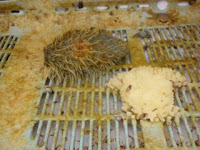 Our Noon Position: 35 48.38 North 121 31.72 West
Our Noon Position: 35 48.38 North 121 31.72 WestToday's blog contributions from Dr. Marcus Eriksen
In 24 hours the wind and boat speed have tripled, and the sea state is choppy, as the low-pressure system to our distant stern has caught up. Yesterday’s calm, glassy sea surface gave rise, quite literally, to a confetti of plastic marine debris. But now, after donning my rainsuit for a brief visit to the bow, I saw less. We know that most of that plastic confetti is polyethylene and polypropylene, which because of its close density to that of water, easily migrates into the water column if things get stormy. This has me thinking about the synthetic “sub-surface” sea.
We’ve seen the rise and fall of polypropylene line as the sea state changes, this happens also with polyethylene fragments. There are other mechanisms as well.
So, if fouling by pelagic organisms makes plastic heavier, then it’s possible that plastic may exist throughout the oceanic water column. There would likely be a bias toward fouling plastic in the gyre because of its longefr residency and fast growth rates of some organisms. There would likely be a bias toward particles with a greater surface area to volume ratio available as habitat.
Typical of any scientific endeavor, one question leads to many more. Would plastic in the water column only be found in transport? What happens when negatively buoyant plastics reach the zone where calcium carbonate dissolves? Will the debris come to the surface again, like a yo-yo? Are there any encrusting pelagic organisms with silica skeletons, like foraminifera and radiolarians? If so, will those organisms sink the plastics they foul to the ocean floor and stay there? Questions lead to more questions.
Aloha and gracias from the captain and crew of ORV Alguita.




1 comment:
Barnacles secrete foam rafts? Please enlighten me on this subject. And what are bryozoans?
West Lafayette High School
Grade 9
Post a Comment